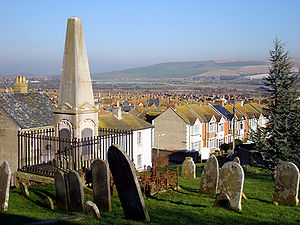HMS Brazen (1798)
| Career (France) | |
|---|---|
| Name: | L'Invincible General Bonaparte |
| Fate: | Captured 9 December 1798 |
| Status: | Privateer |
| Career (UK) | |
| Name: | HMS Brazen |
| Commissioned: | 19 October 1799 |
| Captured: | 9 December 1798 |
| Fate: | Wrecked 26 January 1800 |
| General characteristics | |
| Class and type: | sloop |
| Tonnage: | 363 17/94 bm |
| Length: |
105 ft 2.5 in (32.068 m) (overall) 68 ft 3.875 in (20.8 m) (keel) |
| Beam: | 28 ft 1.5 in (8.573 m) |
| Depth of hold: | 13 ft 7.5 in (4.153 m) |
| Propulsion: | Sails |
| Sail plan: | Sloop |
| Complement: |
|
| Armament: |
|
HMS Brazen was the L'Invincible General Bonaparte (or Invincible Bonaparte or Invincible Buonaparte), a French privateer of 20 guns and 170 men, that the frigate Boadicea captured on 9 December 1798.[1][2] She was sixteen days out of Bordeaux and had not made any captures.[3]
The prize arrived at Spithead on 18 December and in time the Admiralty decided to purchase her. The Admiralty renamed her Brazen and established her as a sloop of war with 16 24-pounder carronades, two 6-pounder guns, and a complement of 120 men.[1] She is best known for her wrecking in January 1800 in which all but one of her crew drowned.
Service
Brazen was fitted for service in the Channel and Captain James Hanson, who had sailed with Captain George Vancouver (1791-4), commissioned her on 19 October 1799. Two weeks later, Captain Andrew Sproule, Commander of the Brighton Sea Fencibles wrote to Captain Henry Cromwell drawing attention to the presence of French privateers off the coast. A week later Admiral Milbanke told the Admiralty in London that 'the Brazen Sloop sailed this morning under orders to cruise "till further notice for the protection of the Trade and annoyance of the enemy between Beachy Head and Dunmose."
She sailed from Morwellham, a small inland Devon port, and on 25 January 1800, she captured a French vessel off the Isle of Wight that Hanson sent into Portsmouth with a 12-man prize crew. This left Brazen a little short-handed.[4][5]
Wreck
Unfortunately, early in the morning on the next day, 26 January, Brazen was wrecked under high cliffs west of Newhaven.[1] Captain Sproule and 20 Sea Fencibles rushed to the site but arrived too late to rescue any of the crew, all but one of whom died.[4] During the following month Sproule and a small group of Sea Fencibles rescued what they could from the Brazen.[4].
As the bodies of the crew washed ashore they were buried in the churchyard of St Michael's in Newhaven. In all, some 95 bodies, out of a crew of about 105, were recovered.[4] Hanson's body, however, was never retrieved.
Postscript
Friends of Captain Hanson erected a monument in the form of an obelisk in the churchyard. The text commemorates Hanson, his officers (who are named), and the crew.[6] In 1878 his widow, Louisa, restored the monument. She lived to the age of 103 and is believed to have been the longest recipient of a naval pension on record.
The wrecking so shocked the people of Newhaven that they formed a committee to investigate how a similar disaster could be avoided. In May 1803, using funds partly raised locally and partly from Lloyd's of London they acquired a rescue lifeboat of Henry Greathead's "Original" design. This was some twenty years before the formation of the Royal National Lifeboat Institution (RNLI).
References
- ↑ 1.0 1.1 1.2 Winfield (2008), p.267.
- ↑ Norie (1842), p.497.
- ↑ Debritt (1794-1802), p.133.
- ↑ 4.0 4.1 4.2 4.3 Chronicles of the sea: or faithful narratives of shipwrecks, fires, famines, and disasters incidental to a life of maritime enterprise; together with celebrated voyages, interesting anecdotes, etc. etc. (1838) (London: William Mark Clark), pp.65-6.
- ↑ The Naval Chronicle, Vol. 3, p. 147-8.
- ↑ Public Sculptures of Sussex
- Debritt, John, ed. (1794–1802) A collection of state papers relative to the war against France now carrying on by Great Britain and the several other European powers". (London : Printed for J. Debrett). Electronic resource: Open Content Alliance.; Boston Library Consortium OCA Digitization Project.
- Norie, John William (1842) The naval gazetteer, biographer and chronologist; containing a history of the late wars from ... 1793 to ... 1801; and from ... 1803 to 1815, and continued, as to the biographical part to the present time. (London, C. Wilson).
- Winfield, Rif (2008). British Warships in the Age of Sail 1793–1817: Design, Construction, Careers and Fates. Seaforth. ISBN 1861762461.
External links
The Sussex Museums Group has a webpage on the Newhaven Local & Maritime Museum. That webpage features a painting of Brazen done by Ted Shipsey, a one-time member of the Newhaven Historical Society, which supports the museum.[1]
The Newhaven Local & Maritime Museum has an extensive collection of information about the wrecking incident, including artefacts recovered from the wreck. It also has the painting featured on the Sussex Museum Group's website, together with three others that Ted Shipsey painted on the theme of the wreck and the rescue.[2]
Lastly, there is also a museum at Morwellham Quay that has some information on Brazen and the wrecking. However, since September 2009 the museum has been in administration.[3]

